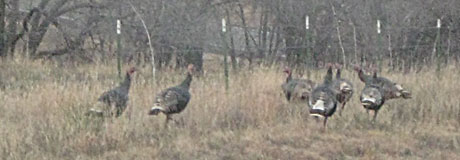After the first of the year, when school is starting again in the U.S., I will write something about surface temperature measurements. Now, since many are out of school and have time to spend outside, it seemed like good timing to post a second blog about birds.
In my last blog, I mentioned observing birds from a blind. What is a blind? It’s a structure that keeps the birds from seeing you. Usually, it’s made up of three walls and a roof, like the one I visit frequently here in Boulder (Figure 1). Blinds are built near places where you would expect birds. For example, there are often blinds near lakes, so that you can watch ducks. One nice thing about observing bird this way is that you can see them really well (you have to be very quiet, so you don’t scare the birds away), and you can photograph them. With the new electronic cameras, it doesn’t take much money to get and print nice pictures of birds.
Figure 1a. Blind at Sawhill Ponds, Boulder.
Figure 1b. View through one of the windows inside the blind.
Last week, we were birding at Palo Duro Canyon (marked by the + sign), which lies southeast of Amarillo, Texas (See Map in Figure 2).
Figure 2. Map showing Palo Duro Canyon, in the Texas Panhandle.
When we paid for going into the park, we were told that there was a blind near the Trading Post, where we could watch the birds. Of course there were many trails to walk on as well, but the blind was special, because we could watch the birds without disturbing them.
Here, the blind was near two bird feeders and an artificial stream where the birds could bathe. There was also a lot of nearby brush so that the birds had a place to escape to if they were frightened. For the humans, there are often benches to sit on inside the blind.
Here are some birds that we saw from the blind.
Figure 3. Fox Sparrow. This bird is about 18 cm long.
Figure 4. Northern Cardinal (22 cm long)
Figure 5. Goldfinch (13 cm long)
Figure 6. Pine Siskin (13 cm long) busily feeding.
Figure 7. White crowned sparrows
These pictures were taken with an ordinary digital camera with a zoom lens. Notice the brush in the background. You can take pictures, too – but avoid using your flash bulb. That will startle the birds. If it is too dark to get pictures without a flash bulb, just enjoy the birds and come back another day to take pictures.
It was fun to watch the birds interact with one another or with other animals. The Cardinal would chase the Goldfinches and Pine Siskins away. They would wait in the bushes until the Cardinal flew away, and then come back in and eat some more. This morning there were several Sparrows (I think) at our feeder here in Boulder this morning. They would take turns eating thistle seed – until a squirrel frightened them away.
Of course we saw birds while hiking at Palo Duro Canyon, but it’s hard to get close enough to photograph them without scaring them away – and we didn’t want to do that. But there was one kind of bird big enough to photograph from a distance – the Wild Turkey (Figure 8). Figure 8 is a bit blurrier than the others because it was taken in dim light and I didn’t have a tripod.

Figure 8. Wild Turkeys (Males are 46 cm long; females 37 cm.)
How do I know what birds these are? Some I learned a long time ago. But when I see a new bird, I look at a field guide with pictures of birds. Or I take notes on what the bird looks like and the way the bird behaves. Is it wagging its tail? Does it fly around a lot? Does it feed on the ground? Does it like to be high up in the trees? How big is it (it helps to have other birds you know nearby for scale, but this doesn’t always happen). Does it eat berries? What is the shape of its bill? Then, when I get home, I can either look at a bird book or find information about the birds on the Web. For a really nice introduction to identifying birds, a very helpful site is All About Birds, and of course there is some really nice information on hummingbirds at the Operation Rubythroat website.
You can have a “blind” at home. Look for a place for a bird feeder outside a window. If there are trees or bushes nearby, the birds have a place to go if they get startled. Look on the web (including the web site sited last time) for how you can make your yard comfortable for birds.
Once you know a few common birds for your area, you can watch for their arrival in the spring or fall. Common birds are probably easiest to use to indicate seasons, since your chances of seeing them are better. In the meantime, enjoy the winter birds!
